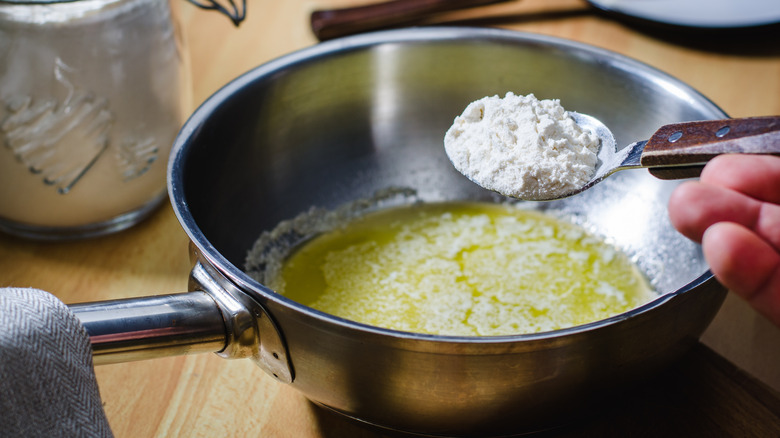Roux Vs. Béchamel: What's The Difference?
The French cooking terms roux and béchamel get tossed around a lot in recipes without much explanation. It's an all-too-familiar problem for someone learning to cook that you stumble on a recipe that asks you to simply "make a roux" and then moves right on to tell you what you should do with it. Maybe you'll get a few hints about what smells and consistencies to look for, but how often are they telling you why you're doing those things? You can follow the instructions, but without knowing what a roux or béchamel is, you may never quite grasp the ideal you're aiming for.
Roux and béchamel are base sauces in French cuisine that are foundational for anyone trying to understand Western cooking. As The Guardian reports, the French literally invented the European restaurant in the 18th century, and the skills and knowledge French chefs built through the professionalization of cooking spread throughout the continent. Roux and béchamel are important because they relate to the five mother sauces of French cuisine, which Food52 notes are the base sauces from which a massive variety of classic dishes spring. A roux isn't one of the five, but it is essential for producing most of them, so it's a great place to start.
What is a roux?
A roux is incredibly useful, and though simple to make, it requires time and attention. According to Bon Appétit, it's made by mixing equal parts flour with a type of fat, usually oil or butter. The mixture is then cooked and used to thicken everything from sauces to soups. Beyond thickening and adding a smooth texture, a roux can form the base for holding ingredients together in a coherent final product, which is why it's the basis for many French mother sauces. One example is velouté, which Saveur states is a roux of flour and butter blended with fish or chicken stock. It's also the same way you make a gravy, or roux mixed with fond and stock or milk. (We told you this was essential.)
The basis for how a roux works is the way starch cooks in fat. According to Serious Eats, when starch molecules are heated in liquid they swell and burst, releasing themselves into the liquid and slowing down the movement of all molecules, thus thickening it. Cooking flour in fat helps the roux stay smooth by keeping the molecules separate and avoiding clumping. A roux can then be cooked to different colors, which bring different characteristics. White roux will thicken better but not add much flavor. A darker roux, like you might use in Cajun gumbo, will add a toasted flavor but won't thicken as well because the extended cooking breaks down the starch too much.
What is béchamel?
One of the best things you can make with a roux is béchamel, one of the five mother sauces. Kitchn states that béchamel, also called white sauce, is perhaps the most common. It's made simply by combining a white roux with milk. Its popularity should be apparent once you realize its affinity for combining with cheese, whether it's on the way to making a creamy mac and cheese, or in a classic lasagna.
To make a béchamel you start with a white roux, which is used mainly for the smooth texture it will produce rather than the flavor. It should only be cooked briefly, just past the point where any raw flour smell has dissipated. Then be patient and slowly mix in the milk while whisking to prevent clumping, before cooking until the béchamel thickens to the desired consistency.
From there, it's off to the races. According to The Spruce Eats, you can make a Mornay sauce by combining béchamel with gruyère and parmesan, and you will want to use it on everything from broccoli to chicken. Food52 notes you can add Dijon and make yourself a tangy, smooth mustard sauce. The best use for béchamel? In our humble opinion, it's the croque monsieur, where the sauce gets cooked both with cheese, and on top of the sandwich, for some bubbling, browned, creamy perfection. There is a reason we all listen to the French vis-à-vis food.


